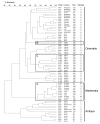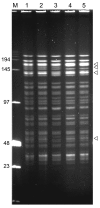Plague outbreak in Libya, 2009, unrelated to plague in Algeria
- PMID: 23347743
- PMCID: PMC3559055
- DOI: 10.3201/eid1902.121031
Plague outbreak in Libya, 2009, unrelated to plague in Algeria
Abstract
After 25 years of no cases of plague, this disease recurred near Tobruk, Libya, in 2009. An epidemiologic investigation identified 5 confirmed cases. We determined ribotypes, Not1 restriction profiles, and IS100 and IS1541 hybridization patterns of strains isolated during this outbreak. We also analyzed strains isolated during the 2003 plague epidemic in Algeria to determine whether there were epidemiologic links between the 2 events. Our results demonstrate unambiguously that neighboring but independent plague foci coexist in Algeria and Libya. They also indicate that these outbreaks were most likely caused by reactivation of organisms in local or regional foci believed to be dormant (Libya) or extinct (Algeria) for decades, rather than by recent importation of Yersinia pestis from distant foci. Environmental factors favorable for plague reemergence might exist in this area and lead to reactivation of organisms in other ancient foci.
Figures





References
-
- Pollitzer R. Plague. WHO monograph series 22. Geneva: World Health Organization; 1954.
-
- Yersin A. Bubonic plague in Hong Kong [in French]. Ann Inst Pasteur (Paris). 1894;8:662–7.
-
- Simond P. The spread of plague [in French]. Ann Inst Pasteur (Paris). 1898;12:625–87.
-
- World Health Organization. Human plague: review of regional morbidity and mortality, 2004–2009. Wkly Epidemiol Rec. 2009;85:40–5. - PubMed
MeSH terms
LinkOut - more resources
Full Text Sources
Other Literature Sources
Medical
